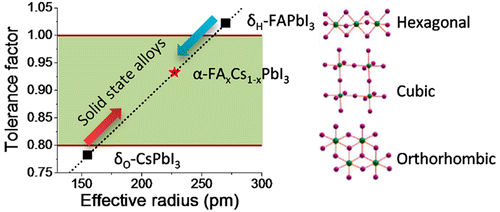当前位置:
X-MOL 学术
›
Chem. Mater.
›
论文详情
Our official English website, www.x-mol.net, welcomes your
feedback! (Note: you will need to create a separate account there.)
Stabilizing Perovskite Structures by Tuning Tolerance Factor: Formation of Formamidinium and Cesium Lead Iodide Solid-State Alloys
Chemistry of Materials ( IF 7.2 ) Pub Date : 2015-12-30 00:00:00 , DOI: 10.1021/acs.chemmater.5b04107 Zhen Li 1 , Mengjin Yang 1 , Ji-Sang Park 1 , Su-Huai Wei 1, 2 , Joseph J. Berry 1 , Kai Zhu 1
Chemistry of Materials ( IF 7.2 ) Pub Date : 2015-12-30 00:00:00 , DOI: 10.1021/acs.chemmater.5b04107 Zhen Li 1 , Mengjin Yang 1 , Ji-Sang Park 1 , Su-Huai Wei 1, 2 , Joseph J. Berry 1 , Kai Zhu 1
Affiliation

|
Goldschmidt tolerance factor (t) is an empirical index for predicting stable crystal structures of perovskite materials. A t value between 0.8 and 1.0 is favorable for cubic perovskite structure, and larger (>1) or smaller (<0.8) values of tolerance factor usually result in nonperovskite structures. CH(NH2)2PbI3 (FAPbI3) can exist in the perovskite α-phase (black phase) with good photovoltaic properties. However, it has a large tolerance factor and is more stable in the hexagonal δH-phase (yellow phase), with δH-to-α phase-transition temperature higher than room temperature. On the other hand, CsPbI3 is stabilized to an orthorhombic structure (δO-phase) at room temperature due to its small tolerance factor. We find that, by alloying FAPbI3 with CsPbI3, the effective tolerance factor can be tuned, and the stability of the photoactive α-phase of the mixed solid-state perovskite alloys FA1–xCsxPbI3 is enhanced, which is in agreement with our first-principles calculations. Thin films of the FA0.85Cs0.15PbI3 perovskite alloy demonstrate much improved stability in a high-humidity environment; this contrasts significantly with the pure FAPbI3 film for which the α-to-δH phase transition (associated with yellowing appearance) is accelerated by humidity environment. Due to phase stabilization, the FA0.85Cs0.15PbI3 solid-state alloy showed better solar cell performance and device stability than its FAPbI3 counterparts. Our studies suggest that tuning the tolerance factor through solid-state alloying can be a general strategy to stabilize the desired perovskite structure for solar cell applications.
中文翻译:

通过调整公差因子稳定钙钛矿结构:甲ami和铯铅碘化物固态合金的形成
Goldschmidt耐受因子(t)是预测钙钛矿材料稳定晶体结构的经验指标。甲吨0.8和1.0之间的值是立方钙钛矿结构有利,以及较大的(> 1)或更小的(<0.8)容许因子的值通常会导致nonperovskite结构。CH(NH 2)2碘化铅3(FAPbI 3)所用的钙钛矿α相(黑色相)具有良好的光伏特性存在。然而,它具有大的容差系数,并且在六边形δ更稳定ħ -PHASE(黄色相)中,用δ ħ -to-α相变温度高于室温。另一方面,CsPbI 3稳定到斜方晶系结构(δ ö相)在室温下由于其小容差系数。我们发现,通过将FAPbI 3与CsPbI 3合金化,可以调节有效的耐受系数,并增强了混合固态钙钛矿合金FA 1– x Cs x PbI 3的光活性α相的稳定性,这是与我们的第一原理计算相符。FA 0.85 Cs 0.15 PbI 3钙钛矿合金的薄膜在高湿环境下表现出大大提高的稳定性;这与纯的FAPbI 3薄膜形成了鲜明的对比,在该薄膜中,α-to-δ潮湿环境会加速H相转变(伴有泛黄现象)。由于具有相稳定性,FA 0.85 Cs 0.15 PbI 3固态合金比FAPbI 3同类合金具有更好的太阳能电池性能和器件稳定性。我们的研究表明,通过固态合金化来调节公差因子可能是稳定太阳能电池应用所需钙钛矿结构的一般策略。
更新日期:2015-12-30
中文翻译:

通过调整公差因子稳定钙钛矿结构:甲ami和铯铅碘化物固态合金的形成
Goldschmidt耐受因子(t)是预测钙钛矿材料稳定晶体结构的经验指标。甲吨0.8和1.0之间的值是立方钙钛矿结构有利,以及较大的(> 1)或更小的(<0.8)容许因子的值通常会导致nonperovskite结构。CH(NH 2)2碘化铅3(FAPbI 3)所用的钙钛矿α相(黑色相)具有良好的光伏特性存在。然而,它具有大的容差系数,并且在六边形δ更稳定ħ -PHASE(黄色相)中,用δ ħ -to-α相变温度高于室温。另一方面,CsPbI 3稳定到斜方晶系结构(δ ö相)在室温下由于其小容差系数。我们发现,通过将FAPbI 3与CsPbI 3合金化,可以调节有效的耐受系数,并增强了混合固态钙钛矿合金FA 1– x Cs x PbI 3的光活性α相的稳定性,这是与我们的第一原理计算相符。FA 0.85 Cs 0.15 PbI 3钙钛矿合金的薄膜在高湿环境下表现出大大提高的稳定性;这与纯的FAPbI 3薄膜形成了鲜明的对比,在该薄膜中,α-to-δ潮湿环境会加速H相转变(伴有泛黄现象)。由于具有相稳定性,FA 0.85 Cs 0.15 PbI 3固态合金比FAPbI 3同类合金具有更好的太阳能电池性能和器件稳定性。我们的研究表明,通过固态合金化来调节公差因子可能是稳定太阳能电池应用所需钙钛矿结构的一般策略。





















































 京公网安备 11010802027423号
京公网安备 11010802027423号